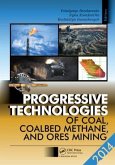Geomechanics of Coal Seams explores the evolving role of coal, transitioning from a historically criticized energy source tied to the Industrial Revolution, to a material with the potential to play a significant role in achieving net-zero greenhouse gas emissions. Traditionally used as raw material, coal now serves as a reservoir for natural gas or carbon dioxide storage, offering a path toward reducing global greenhouse gas emissions. Despite its promise, challenges remain, particularly regarding its geomechanical behavior. This book delves into the unique properties of coal, covering everything from geological foundations to numerical modeling. Aimed at students, researchers, and engineers, the book provides valuable insights applicable to other microporous materials.
Bitte wählen Sie Ihr Anliegen aus.
Rechnungen
Retourenschein anfordern
Bestellstatus
Storno









